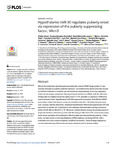Mostrar o rexistro simple do ítem
Hypothalamic miR-30 regulates puberty onset via repression of the puberty-suppressing factor, Mkrn3
| dc.contributor.author | Heras, Violeta | |
| dc.contributor.author | Sangiao-Alvarellos, Susana | |
| dc.contributor.author | Manfredi-Lozano, María | |
| dc.contributor.author | Sánchez-Tapia, María J. | |
| dc.contributor.author | Ruiz-Pino, Francisco | |
| dc.contributor.author | Roa, Juan | |
| dc.contributor.author | Lara-Chica, Maribel | |
| dc.contributor.author | Morrugares-Carmona, Rosario | |
| dc.contributor.author | Jouy, Nathalie | |
| dc.contributor.author | Abreu, Ana P. | |
| dc.contributor.author | Prevot, Vincent | |
| dc.contributor.author | Belsham, Denise | |
| dc.contributor.author | Vázquez, María J. | |
| dc.contributor.author | Calzado, Marco A. | |
| dc.contributor.author | Pinilla, Leonor | |
| dc.contributor.author | Gaytán, Francisco | |
| dc.contributor.author | Latronico, Ana C. | |
| dc.contributor.author | Kaiser, Ursula B. | |
| dc.contributor.author | Castellano, Juan M. | |
| dc.contributor.author | Tena-Sempere, Manuel | |
| dc.date.accessioned | 2020-01-02T12:06:45Z | |
| dc.date.available | 2020-01-02T12:06:45Z | |
| dc.date.issued | 2019-11-07 | |
| dc.identifier.citation | Heras V, Sangiao-Alvarellos S, Manfredi-Lozano M, Sanchez-Tapia MJ, Ruiz-Pino F, Roa J, Lara-Chica M, Morrugares-Carmona R, Jouy N, Abreu AP, Prevot V, Belsham D, Vazquez MJ, Calzado MA, Pinilla L, Gaytan F, Latronico AC, Kaiser UB, Castellano JM, Tena-Sempere M. Hypothalamic miR-30 regulates puberty onset via repression of the puberty-suppressing factor, Mkrn3. PLoS Biol. 2019 Nov 7;17(11):e3000532. | es_ES |
| dc.identifier.issn | 15457885 | |
| dc.identifier.uri | http://hdl.handle.net/2183/24561 | |
| dc.description.abstract | [Abstract] Mkrn3, the maternally imprinted gene encoding the makorin RING-finger protein-3, has recently emerged as putative pubertal repressor, as evidenced by central precocity caused by MKRN3 mutations in humans; yet, the molecular underpinnings of this key regulatory action remain largely unexplored. We report herein that the microRNA, miR-30, with three binding sites in a highly conserved region of its 30 UTR, operates as repressor of Mkrn3 to control pubertal onset. Hypothalamic miR-30b expression increased, while Mkrn3 mRNA and protein content decreased, during rat postnatal maturation. Neonatal estrogen exposure, causing pubertal alterations, enhanced hypothalamic Mkrn3 and suppressed miR-30b expression in female rats. Functional in vitro analyses demonstrated a strong repressive action of miR-30b on Mkrn3 30 UTR. Moreover, central infusion during the juvenile period of target site blockers, tailored to prevent miR-30 binding to Mkrn3 30 UTR, reversed the prepubertal down-regulation of hypothalamic Mkrn3 protein and delayed female puberty. Collectively, our data unveil a novel hypothalamic miRNA pathway, involving miR-30, with a prominent role in the control of puberty via Mkrn3 repression. These findings expand our current understanding of the molecular basis of puberty and its disease states. | es_ES |
| dc.description.sponsorship | This work was supported by grants BFU2014-57581-P and BFU2017-83934-P (Ministerio de Economía y Competitividad, Spain; co-funded with EU funds from FEDER Program); project PIE-00005 (Flexi-Met, Instituto de Salud Carlos III, Ministerio de Sanidad, Spain); Project P12-FQM-01943 (Junta de Andalucía, Spain); and Project REP-655232 (ReprObesity, European Union). CIBER Fisiopatología de la Obesidad y Nutrición is an initiative of Instituto de Salud Carlos III. | es_ES |
| dc.description.sponsorship | info:eu-repo/grantAgreement/MINECO/Programa Estatal de Fomento de la Investigación Científica y Técnica de Excelencia/BFU2014-57581-P/ES/ANALISIS DEL PAPEL DE LAS KISSPEPTINAS COMO ELEMENTOS CLAVE EN EL CONTROL DE LA PUBERTAD: NUEVAS INTERACCIONES, MECANISMOS REGULADORES E IMPLICACIONES METABOLICAS | es_ES |
| dc.description.sponsorship | info:eu-repo/grantAgreement/AEI/Programa Estatal de Fomento de la Investigación Científica y Técnica de Excelencia/BFU2017-83934-P/ES/KISSPEPTINAS Y PUBERTAD - NUEVOS ASPECTOS FISIOLOGICOS E IMPLICACIONES FISIOPATOLOGICAS EN ALTERACIONES PUBERALES ASOCIADAS A OBESIDAD | es_ES |
| dc.description.sponsorship | Instituto de Salud Carlos III; PIE-00005 | |
| dc.description.sponsorship | Junta de Andalucía; P12-FQM-01943 | |
| dc.language.iso | eng | es_ES |
| dc.publisher | Public Library of Science (PLoS) | es_ES |
| dc.relation.uri | https://doi.org/10.1371/journal.pbio.3000532 | es_ES |
| dc.rights | Creative Commons Attribution 4.0 International License (CC-BY 4.0) | es_ES |
| dc.rights.uri | http://creativecommons.org/licenses/by/4.0/ | * |
| dc.title | Hypothalamic miR-30 regulates puberty onset via repression of the puberty-suppressing factor, Mkrn3 | es_ES |
| dc.type | info:eu-repo/semantics/article | es_ES |
| dc.rights.access | info:eu-repo/semantics/openAccess | es_ES |
| UDC.journalTitle | PLoS Biology | es_ES |
| UDC.volume | 17 | es_ES |
| UDC.issue | 11 | es_ES |
| UDC.startPage | e3000532 | es_ES |
Ficheiros no ítem
Este ítem aparece na(s) seguinte(s) colección(s)
-
GI-FENM - Artigos [117]
-
INIBIC-EENM - Artigos [52]






